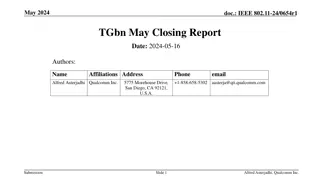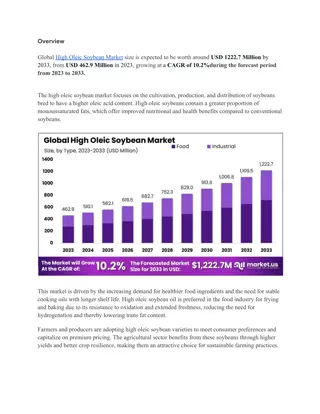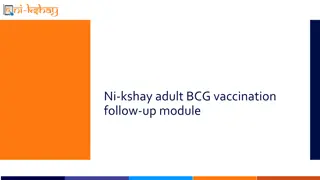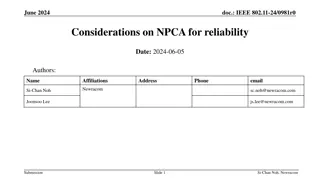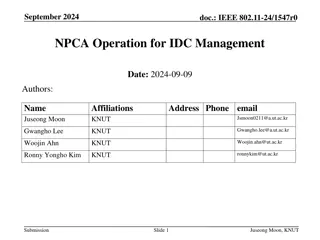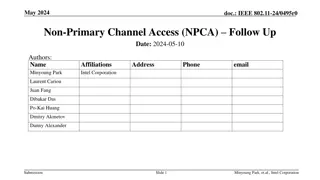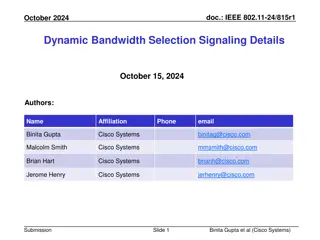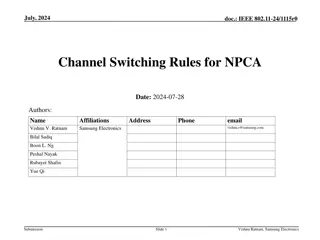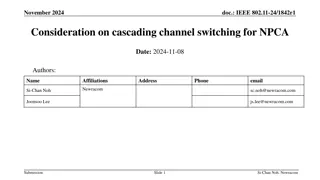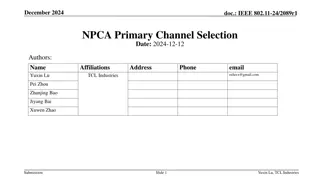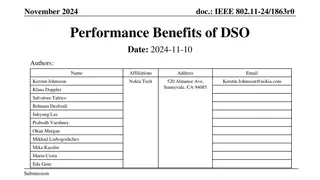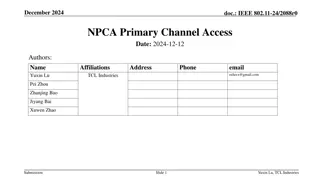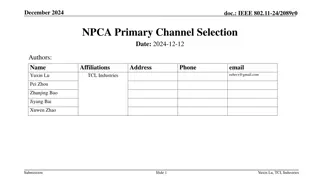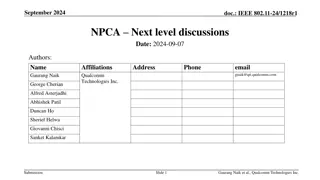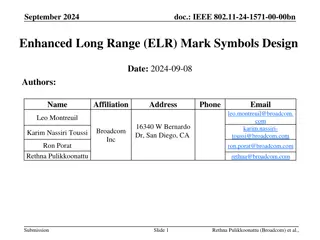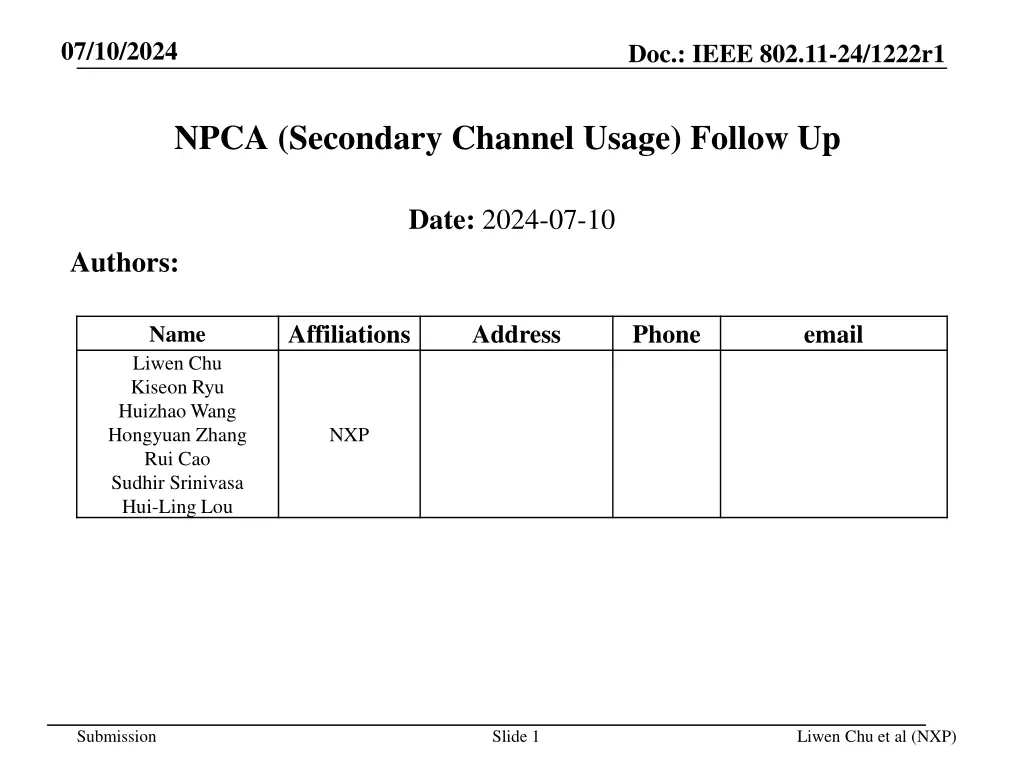
Optimizing Secondary Channel Usage in IEEE 802.11 Networks
Explore the key considerations for enhancing secondary channel usage in IEEE 802.11 networks, including channel switch delay, consideration of switch times, and NPAA switch threshold announcements for efficient communication protocols and device readiness.
Download Presentation

Please find below an Image/Link to download the presentation.
The content on the website is provided AS IS for your information and personal use only. It may not be sold, licensed, or shared on other websites without obtaining consent from the author. If you encounter any issues during the download, it is possible that the publisher has removed the file from their server.
You are allowed to download the files provided on this website for personal or commercial use, subject to the condition that they are used lawfully. All files are the property of their respective owners.
The content on the website is provided AS IS for your information and personal use only. It may not be sold, licensed, or shared on other websites without obtaining consent from the author.
E N D
Presentation Transcript
07/10/2024 Doc.: IEEE 802.11-24/1222r1 NPCA (Secondary Channel Usage) Follow Up Date: 2024-07-10 Authors: Affiliations Address Phone email Name Liwen Chu Kiseon Ryu Huizhao Wang Hongyuan Zhang Rui Cao Sudhir Srinivasa Hui-Ling Lou NXP Submission Slide 1 Liwen Chu et al (NXP)
07/10/2024 Doc.: IEEE 802.11-24/1222r1 Recap We discussed the secondary channel usage in several presentations: The RU index, BW negotiation in secondary channel Secondary channel usage and TXOP BW, channel puncture. Secondary channel usage under Multiple BSSID or co-hosted APs. Secondary channel usage and Beacon Tx. Secondary channel usage and R-TWT. Secondary channel usage and NAV operation. Submission Slide 2 Liwen Chu et al (NXP)
07/10/2024 Doc.: IEEE 802.11-24/1222r1 Channel Switch Delay The switch time from the NPCA primary channel to the primary channel and the switch time from the primary channel to the NPCA primary channel need to be announced to the peer device. Capability parameter vs operating parameter: The switch time between NPCA primary channel and the primary channel should be operating parameter since when a STA s operating BW changes the channel switch delay may change, e.g. the channel switch time when the STA s operating BW cover NPCA primary channel and the channel switch time when the STA s operating BW doesn t cover NPCA primary channel are different. This means that when a non-AP STA negotiates the enabling of NPCA operation, the STA announces its switch time between NPCA primary channel and the primary channel. An AP can announce its channel switch time for NPCA in its Beacon. Submission Slide 3 Liwen Chu et al (NXP)
07/10/2024 Doc.: IEEE 802.11-24/1222r1 Consideration of Different Switch Time The TXOP holder on NPCA primary channel that transmits the initial frame to the peer device needs to guarantee that the peer device is ready to receive the frame. Otherwise, the unnecessary backoff may happen. When switching to NPCA primary channel, an NPCA STA as TXOP holder can t transmit the initial PPDU to a peer device before the peer device s announced switch delay from the primary channel to NPCA primary channel based on the common understanding of the time point when the subchannel switch starts. Submission Slide 4 Liwen Chu et al (NXP)
07/10/2024 Doc.: IEEE 802.11-24/1222r1 NPCA Switch Threshold An NPCA AP needs to announce a threshold (the minimum duration threshold of the BSS primary channel busyness because of OBSS activity for switching to NPCA primary channel). If the duration of the OBSS activity that makes the primary channel busy is smaller than the duration threshold, the NPCA STAs (AP and non-AP) do not switch to the NPCA primary channel. Submission Slide 5 Liwen Chu et al (NXP)
07/10/2024 Doc.: IEEE 802.11-24/1222r1 EDCA on NPCA Primary Channel After switching to the NPCA primary channel, a STA/AP needs to initiate the backoff by setting the backoff timer with a random number selected per the CW before executing the frame exchanges on the NPCA primary channel. The (MU)EDCA parameter set on the NPCA primary channel is same as the (MU)EDCA parameter set on the primary channel The CW is set to CWmin right after switching to the NPCA primary channel. The QSRC for each AC is set to 0 after switching to the NPCA primary channel. The backoff counter, CW, QSRC for the NPCA primary channel s bakcoff are independent from the backoff counter, CW, QSRC for the primary channel s bakcoff. Submission Slide 6 Liwen Chu et al (NXP)
03/06/2024 Doc.: IEEE 802.11-24/1222r1 EDCA on Primary Channel After switching back to the primary channel, a STA/AP needs to resume the backoff per the backoff counter, CW, QSRC right before switching to the NPCA primary channel. Basic NAV timer: Option 1: The basic NAV Timer needs to be resumed per the recorded primary channel basic NAV timer value. Option 2: If the basic NAV timer in NPCA channel has larger value than the recorded basic NAV timer on primary channel, the basic NAC timer of primary channel is set per the basic NAV timer of the NPCA primary channel. Otherwise, the basic NAV Timer needs to be resumed per the recorded primary channel basic NAV timer value. Option 3: If the basic NAV timer in NPCA channel has larger value than the recorded basic NAV timer on primary channel and the basic NAV timer s BW information indicates the coverage of the primary channel, the basic NAC timer of primary channel is set per the basic NAV timer of NPCA channel. Otherwise, the basic NAV Timer needs to be resumed per the recorded primary channel basic NAV timer value. Submission Slide 7 Liwen Chu et al (NXP)
07/10/2024 Doc.: IEEE 802.11-24/1222r1 Summary The following are discussed: The switch delay from the primary channel to the NPCA primary channel and the switch delay from the NPCA primary channel to the primary channel The frame exchanges in NPCA primary channel under the different switch delay The OBSS activity threshold to decide whether to switch to the NPCA primary channel EDCA procedures on the primary channel and on the NPCA primary channel Submission Slide 8 Liwen Chu et al (NXP)
07/10/2024 Doc.: IEEE 802.11-24/1222r1 SP 1 Do you agree that when an NPCA STA switches to the NPCA Primary channel, it shall not initiate a transmission to its peer NPCA STA until the peer STA s switching delay has elapsed since TBD switch start time? Submission Slide 9 Liwen Chu et al (NXP)
07/10/2024 Doc.: IEEE 802.11-24/1222r1 SP 2 Do you support that an AP that enables NPCA announces the minimum duration threshold of the BSS primary channel busyness because of OBSS activity for switching to NPCA primary channel? If the duration of the OBSS activity that makes the primary channel busy is smaller than the duration threshold, the NPCA STAs (AP and non-AP) do not switch to the NPCA primary channel. Submission Slide 10 Liwen Chu et al (NXP)
07/10/2024 Doc.: IEEE 802.11-24/1222r1 Backup Slides Submission Slide 11 Liwen Chu et al (NXP)
07/10/2024 Doc.: IEEE 802.11-24/1222r1 Channel Switch Delay Granularity: The granularity of EMLSR/EMLMR is not linear where the maximal granularity is 128us (0, 32, 64, 128, 256us). The large granularity will waste the medium time. The padding time of 11ax has granularity of 8us (0, 8, 16us). Is the granularity of one us necessary? This may increase the medium efficiency a little bit, e.g. a BSRP Trigger with 2us room to carry all the addressed STAs User Info fields doesn t need additional OFDM symbols to carry the padding field if all the padding requirement of all the addressed STAs are no more than 2us. Will this increase the implementation complexity No, a device can select a larger padding time when a peer device announces a smaller value. We prefer either 1us granularity or 8us granularity. Submission Slide 12 Liwen Chu et al (NXP)
07/10/2024 Doc.: IEEE 802.11-24/1222r1 STA without Enabling Secondary Channel Usage An AP that switches to the anchor channel is not allowed to transmit the frame(s) to a STA that does not enable its NPCA. Submission Slide 13 Liwen Chu et al (NXP)
03/06/2024 Doc.: IEEE 802.11-24/1222r1 Synchronization on NPCA Primary Channel Medium synchronization on the NPCA primary channel If a STA/AP can t do the CCA on the NPCA primary channel for more than 72us (aMediumSyncThreshold) until finishing the switch to the NPCA primary channel, the STA/AP loses the medium synchronization when switching to the NPCA primary channel. Otherwise, the STA/AP does not lose the medium synchronization when switching to the NPCA primary channel. During the transmission/detection of a PPDU that cover the NPCA primary channel, the CCA result of the NPCA primary channel is medium busy. During the time switching from the primary channel to the NPCA primary channel, the STA/AP can t do the CCA on the anchor channel. Submission Slide 14 Liwen Chu et al (NXP)
07/10/2024 Doc.: IEEE 802.11-24/1222r1 Synchronization on Primary Channel The TXOP in NPCA needs to guarantees that a STA/AP that switches from the NPCA primary channel to the primary channel does not loses the medium synchronization. Submission Slide 15 Liwen Chu et al (NXP)
07/10/2024 Doc.: IEEE 802.11-24/1222r1 Available Secondary Channel When the duration of an OBSS PPDU is used to decide the maximal staying time on NPCA primary channel, secondary channel occupied by the PPDU can t be selected by the TXOP holder to do the frame exchanges in a TXOP through the backoff on NPCA primary channel. When the duration of an OBSS TXOP is used to decide the maximal staying time on NPCA primary channel, secondary channel occupied by the TXOP BW can t be selected by the TXOP holder to do the frame exchanges in a TXOP through the backoff on NPCA primary channel. The TXOP BW of a TXOP is the maximal BW of the PPDUs in the TXOP. Submission Slide 16 Liwen Chu et al (NXP)

